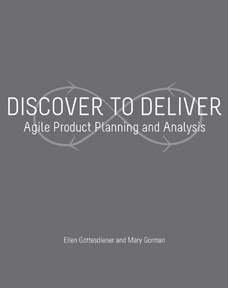Essential Agile Business Analysis
 by Mary Gorman and Ellen Gottesdiener
by Mary Gorman and Ellen Gottesdiener
For years and years we’ve coached and trained teams how to elicit, analyze, and manage requirements for software development projects. We also work on projects—so our coaching and training is based on real project work. We’ve just written a book on agile product planning and analysis. Now that so many organizations adopting Agile as the method of choice, what about requirements? Is there a need for analyzing requirements in Agile?
That was the theme of our June Webinar titled (spoiler alert!) “Business Analysis Is Essential to Agile Success” (use training@ebgconsulting.com to login). For our blog eNewsletter readers, here’s the nugget: requirements drive agile teams! When you collaboratively analyze requirements, you accelerate development and delivery of high-value products, which is the whole point of Agile. What’s more, the ability to be focused, nimble, and disciplined about your requirements is essential for successful Agile delivery.
When you adopt Agile practices, you plan and analyze regularly to support a steady flow of product delivery. On Agile projects, the key is to plan to re-plan. A plan represents your allocation of requirements—options for satisfying product needs—to delivery cycles.
With Agile, you don’t try to elicit all the possible product needs (requirements) up front and create one big plan. Instead, you plan continually, using feedback from prior deliveries to adjust your plan. This in turn means you continually analyze product needs to discover high-value options for the next delivery. Planning and analysis are interdependent and synergistic. See this article for more details.
Fresh Ingredients
Here’s another way to think of Agile analysis: It’s done just-in-time—you want your requirements to be “fresh.” You adjust the precision and granularity of requirements taking a just-enough approach. To do that, you need to use proven analysis tools and techniques you’re probably already familiar with. For example, you might sketch a context diagram to quickly visualize the interfaces needed for a release, a minimum marketable feature, a use case, or a story. Or you organically explore requirements using a data model or state diagram. For more ideas to tune your analysis techniques for Agile, go here.
The Product Partnership
What about business analysts—do they have a role on Agile teams? In our forthcoming book Discover to Deliver: Agile Product Planning and Analysis, we write about forming a product partnership to collaborate in discovering and delivering valued products. The partners include diverse perspectives from the business, customer, and technology communities. We have found this partnership is critical for Agile product success. (Read more about our new book, Discover to Deliver: Agile Product Planning and Analysis, here.)
Agile Analysis
Business analysts ask us where they fit in this partnership. Our response? “What are your skills?” An Agile team needs strong skills in analysis, modeling, elicitation, facilitation, risk analysis, prioritization, strategic thinking, verification, and validation, along with a sound understanding of the product’s domain. The person who possesses these skills will be a valuable and valued team member. Check out this article, “It’s the Goal, not the Role,” for more details.
In short, successful Agile teams have figured out how to reach a shared understanding of high-value product needs and to build each high-value increment quickly and efficiently. Each member of the team provides critical skills and knowledge.
Additional Readings and References:
- EBG Consulting, 2010. Agile Analysis Challenges.
- EBG Consulting, 2012. “Business Analysis is Essential to Agile Success”, webinar available here.
- Gottesdiener, Ellen and Mary Gorman. “It’s the Goal, Not the Role: The Value of Business Analysis in Scrum“, Agile Journal, (August, 2011)
- Gottesdiener, Ellen and Mary Gorman. “Agile Planning and Analysis: Synergizing to Deliver Value,” Better Software, May/June 2011.

Leave a Reply